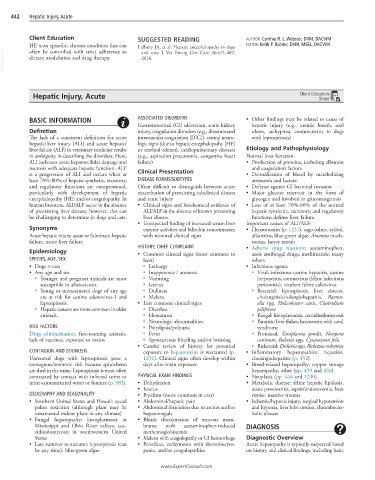Page 907 - Cote clinical veterinary advisor dogs and cats 4th
P. 907
442 Hepatic Injury, Acute
Client Education SUGGESTED READING AUTHOR: Cynthia R. L. Webster, DVM, DACVIM
HE is an episodic, chronic condition that can Lidbury JA, et al: Hepatic encephalopathy in dogs EDITOR: Keith P. Richter, DVM, MSEL, DACVIM
VetBooks.ir dietary modulation and drug therapy. 2016.
often be controlled with strict adherence to
and cats. J Vet Emerg Crit Care 26:471-487,
Hepatic Injury, Acute Client Education
Sheet
BASIC INFORMATION ASSOCIATED DISORDERS • Other findings may be related to cause of
Gastrointestinal (GI) ulceration, acute kidney hepatic injury (e.g., uremic breath, oral
Definition injury, coagulation disorders (e.g., disseminated ulcers, tachypnea, conjunctivitis in dogs
The lack of a consistent definition for acute intravascular coagulation [DIC]), central neuro- with leptospirosis)
hepatic/liver injury (ALI) and acute hepatic/ logic signs (due to hepatic encephalopathy [HE]
liver failure (ALF) in veterinary medicine results or cerebral edema), cardiopulmonary diseases Etiology and Pathophysiology
in ambiguity in describing the disorders. Here, (e.g., aspiration pneumonia, congestive heart Normal liver function:
ALI indicates acute hepatocellular damage and failure) • Production of proteins, including albumin
necrosis with adequate hepatic function. ALF Clinical Presentation and coagulation factors
is a progression of ALI and occurs when at • Detoxification of blood by metabolizing
least 70%-80% of hepatic synthetic, excretory, DISEASE FORMS/SUBTYPES ammonia and lactate
and regulatory functions are compromised, Often difficult to distinguish between acute • Defense against GI bacterial invasion
particularly with development of hepatic exacerbation of preexisting subclinical disease • Major glucose reservoir in the form of
encephalopathy (HE) and/or coagulopathy. In and acute injury glycogen and involved in gluconeogenesis
human literature, ALI/ALF occur in the absence • Clinical signs and biochemical evidence of • Loss of at least 70%-80% of the normal
of preexisting liver disease; however, this can ALI/ALF in the absence of known preexisting hepatic synthetic, excretory, and regulatory
be challenging to determine in dogs and cats. liver disease functions defines liver failure.
• Unexpected finding of increased serum liver Important causes of ALI/ALF:
Synonyms enzyme activities and bilirubin concentration • Hepatotoxins (p. 1231): sago palms, xylitol,
Acute hepatic injury, acute or fulminant hepatic with minimal clinical signs aflatoxins, blue-green algae, Amanita mush-
failure, acute liver failure rooms, heavy metals
HISTORY, CHIEF COMPLAINT • Adverse drug reactions: acetaminophen,
Epidemiology • Common clinical signs (most common to azole antifungal drugs, methimazole, many
SPECIES, AGE, SEX least) others
• Dogs > cats ○ Lethargy • Infectious agents
• Any age and sex ○ Inappetence / anorexia ○ Viral: infectious canine hepatitis, canine
○ Younger and pregnant animals are most ○ Vomiting herpesvirus, coronavirus (feline infectious
susceptible to aflatoxicosis. ○ Icterus peritonitis), virulent feline calicivirus
○ Young or unvaccinated dogs of any age ○ Dullness ○ Bacterial: leptospirosis, liver abscess,
are at risk for canine adenovirus-1 and ○ Melena cholangitis/cholangiohepatitis, Barton-
leptospirosis. • Less common clinical signs ella spp, Helicobacter canis, Clostridium
○ Hepatic cancers are more common in older ○ Diarrhea piliforme
animals. ○ Hematuria ○ Fungal: histoplasmosis, coccidioidomycosis
○ Neurologic abnormalities ○ Parasitic: liver flukes; heartworm with caval
RISK FACTORS ○ Polydipsia/polyuria syndrome
Drug administration, free-roaming animals, ○ Fever ○ Protozoal: Toxoplasma gondii, Neospora
lack of vaccines, exposure to toxins ○ Spontaneous bleeding and/or bruising caninum, Babesia spp, Cytauxzoon felis
• Careful review of history for potential ○ Rickettsial: Ehrlichia spp, Rickettsia rickettsiae
CONTAGION AND ZOONOSIS exposure to hepatotoxins is warranted (p. • Inflammatory hepatopathies: hepatitis,
Untreated dogs with leptospirosis pose a 1231). Clinical signs often develop within cholangiohepatitis (p. 452)
contagious/zoonotic risk because spirochetes days after toxin exposure. • Breed-related hepatopathy: copper storage
are shed in the urine. Leptospirosis is most often hepatopathy, other (pp. 459 and 450)
contracted by contact with infected urine or PHYSICAL EXAM FINDINGS • Neoplasia (pp. 446 and 1230)
urine-contaminated water or fomites (p. 583). • Dehydration • Metabolic disease: feline hepatic lipidosis,
• Icterus acute pancreatitis, sepsis/endotoxemia, heat
GEOGRAPHY AND SEASONALITY • Ptyalism (more common in cats) stroke, massive trauma
• Southern United States and Hawaii: cycad • Abdominal/hepatic pain • Ischemia/hypoxic injury: surgical hypotension
palms toxicities (although plant may be • Abdominal distention due to ascites and/or and hypoxia, liver lobe torsion, thromboem-
ornamental indoor plant in any climate) hepatomegaly bolic disease
• Fungal hepatopathy: histoplasmosis in • Bluish discoloration of mucous mem-
Mississippi and Ohio River valleys; coc- branes with acetaminophen-induced DIAGNOSIS
cidioidomycosis in southwestern United methemoglobinemia
States • Melena with coagulopathy or GI hemorrhage Diagnostic Overview
• Late summer to autumn: leptospirosis (can • Petechiae, ecchymoses with thrombocyto- Acute hepatopathy is typically suspected based
be any time), blue-green algae penia, and/or coagulopathies on history and clinical findings, including basic
www.ExpertConsult.com

